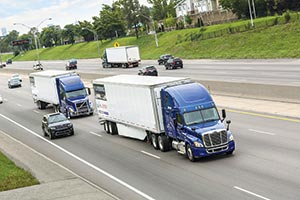States Partner for Testing, Research of Autonomous, Platooning Vehicles

This story appears in the Feb. 6 print edition of Transport Topics.
Three states are joining forces to work on autonomous and connected vehicles research and testing.
After more than a year of discussion, the adjoining states of Michigan, Ohio and Pennsylvania announced Jan. 17 that they have formed the Smart Belt Coalition, which is made up of the departments of transportation in the three states, the University of Michigan, the Ohio State University and Carnegie Mellon University, as well as the Ohio Turnpike and Infrastructure Commission, the Pennsylvania Turnpike Commission and Ohio’s Transportation Research Center.
“When you work on automated and connected vehicles, you get to know people from other state DOTs who are doing the same thing,” Erin Waters-Trasatt, PennDOT’s point person for the coalition, told Transport Topics. “Michigan has, like Pennsylvania, been a leader in this space.” Both states have USDOT- designated proving grounds.
She added, “Ohio is our neighbor, so we have mutual freight corridors, and Columbus won the [USDOT’s] Smart City Challenge. It’s just a natural fit for the three states.”
Ohio just allocated $45 million in state grants to a research center/test track/proving ground in the heart of the state. Autonomous vehicles and platooning trucks became legal last year in Michigan, and Uber has made Pennsylvania, specifically Pittsburgh, a home of autonomous vehicle testing.
Ohio Turnpike Executive Director Randy Cole said the meetings of players from the three states have the feel of internal meetings, which makes collaboration even smoother.
“We can align our efforts so that we don’t duplicate and work on different pieces of the puzzle,” Cole told TT. “We do believe that … the fact that we’re aligning efforts sends a clear signal to private companies, whether they’re freight-related companies like Otto or Peloton, or transportation technology companies like Uber or Google, that our states are open for business, and to the federal government and researchers that we’re a much larger test bed that doesn’t stop at state lines.”
Matt Smith, MDOT’s point person for the coalition, agreed with Cole that joint efforts just make sense.
“It’s just a great opportunity to leverage the efforts that we all have going on,” Smith told TT. “There’s a lot to be learned about how these systems and solutions work across state lines. We all have common goals. Freight movement is huge in all of our states. We’re hoping to encourage a truck platooning operation from Pittsburgh all the way almost to Michigan’s border with Canada.”
Cole noted that 12 million of the Ohio Turnpike’s record 54 million trips last year involved freight movement. Those trips accounted for more than 1 billion miles on the 160-mile turnpike.
“We don’t have any managed lanes, so we have freight and passengers consistently in the same traffic flow,” he said. “So it’s important to us that we get the safety and efficiency gains promised by the new technology across both segments of our customer base.”
Smith added that coalition may expand. “We’ve heard from a couple of other states and our neighbor to the north,” he said, noting that Michigan and Ontario signed a memorandum of understanding on these issues.

